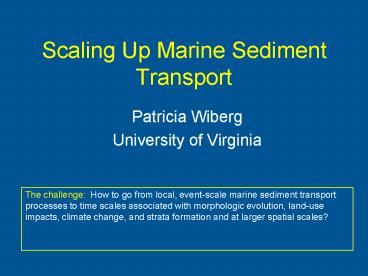Scaling Up Marine Sediment Transport - PowerPoint PPT Presentation
1 / 27
Title:
Scaling Up Marine Sediment Transport
Description:
Scaling Up Marine Sediment Transport Patricia Wiberg University of Virginia The challenge: How to go from local, event-scale marine sediment transport processes to ... – PowerPoint PPT presentation
Number of Views:86
Avg rating:3.0/5.0
Title: Scaling Up Marine Sediment Transport
1
Scaling Up Marine Sediment Transport
- Patricia Wiberg
- University of Virginia
The challenge How to go from local, event-scale
marine sediment transport processes to time
scales associated with morphologic evolution,
land-use impacts, climate change, and strata
formation and at larger spatial scales?
2
Possible approaches
- 1. Extend local, event-scale models by
- enlarging the spatial context e.g., CSTMS-ROMS,
Delft3D - increasing the time step (with appropriate model
adjustments) e.g., Xbeach - running them for a series of real or synthetic
events to develop a distribution of responses to
a distribution of forcing e.g., Swift et al
3
Possible approaches
- 2. Develop simpler, time-averaged representation
- diffusion or advection-diffusion formulation
- solve for equilibrium shelf profile based on
balance of dominant processes e.g. Friedrichs
and Scully - determine an effective storm to represent the
net effect of storms on moving sediment over some
time period e.g. Swensen - geometric models of margin stratigraphy e.g.
Steckler
4
Recent progress in hillslope diffusion
- e.g.,Tucker and Bradley, 2010 Trouble with
diffusion - Foufoula-Georgiou et al, 2010 Non-local
fluxes on hillslopes - Some conclusions
- Most GTLs are local, but disturbances that induce
transport can produce a large range of transport
distances - Connections between non-local and non-linear flux
dependence on slope - Promising alternatives to local diffusion include
particle-based models and non-local transport
models
5
Shelf vs hillslope transport
- Multidirectional vs downslope transport
- Mostly flow-driven rather than slope-driven
- Wave vs runoff response to storms waves are
inefficient mass transporters - Response of currents to storms is limited flow
at bed can be decoupled from surface flow - Suspended sediment mass is limited by near-bed
stratification when wave gtgt current velocities
6
Shelf vs hillslope transport
- River mouths are upslope point sources of
sediment active during floods - Floods (-gt sed delivery) and waves (-gt sed
mobilization) may or may not be coherent - Sediment availability is supply limited owing to
consolidation and small active layer depths - Wave-supported gravity flows can advect large
quantities of recently supplied flood sediment
across the shelf
7
- Waves control timing and duration of transport
- Currents control direction and vertical
distribution of flux - Tides are an ever-present source of variance,
turbulent mixing in the system
S60 site on the Eel shelf
8
- All combine to affect the magnitude of the flux
- Volume in suspension limited by availability
- Short time-scale models do a reasonably good job
of predicting SSC and fluxes
9
Shelf sediment diffusivity
- Important to capture effects of waves, currents
and tides on diffusivity - Expect diffusivity to vary with depth and
sediment conditions - May provide a measure of sediment transport
potential on the shelf - Would need to be combined with flux due to
wave-supported gravity flows
10
(No Transcript)
11
500 particles, initially at a depth of 60 m,
moving across and along the shelf for a period of
14 days.
12
(No Transcript)
13
Cross-shelf distance (km)
14
Transport rates on the Eel shelf are higher than
on the Russian shelf
Flux difference
55-60 tidal
15-20 subtidal currents
15-20 waves
5-10 sediment
Total flux on Eel shelf 4.6 x total flux on
Russian shelf
15
(No Transcript)
16
Effects of grain size
17
Concentration gradient on which diffusion acts is
defined by the depth of the active layer of the
bed
- Active layer depth (ALD) controlled by
- ripple geometry and transport rate (sand beds)
- consolidation state of bed (mud beds)
18
Five-year calculation of bed-level change by
diffusive transport
Depths of erosion and deposition depend on active
layer thickness and the time scale for resetting
the active layer once exhausted
19
Effect of active-layer recovery time on depths of
erosion and deposition.
Active layer depth reset every 2 weeks
reset every month
Depth (m)
reset every year
reset every season
Depth (m)
Distance from shore (km)
Distance from shore (km)
20
Possible next steps
- Extend the random walk calculations to include
sediment fluxes directly -gt particle-based model - Could build in triggers for cross-shelf advection
by wave-supported gravity flows
21
Geyer/Traykovski, WHOI
22
Possible next steps
- Extend the random walk calculations to include
sediment fluxes directly -gt particle-based model - Map shelf diffusivity as a measure of sediment
transport potential (requires spatial wave,
current and tide time series) - How do spatial variations in diffusivity affect
sediment redistribution on the shelf?
23
NOAAs WaveWatch III operational wave model
24
Possible next steps
- Extend the random walk calculations to include
sediment fluxes directly -gt particle-based model - Map shelf diffusivity as a measure of sediment
transport potential (requires spatial wave,
current and tide time series) - Investigate effects of textural variations, flood
deposition, consolidation times on fluxes
25
Geostatistical simulations of erodibilty on the
Palos Verdes shelf, CA
26
Conclusions
- A range of problems need long-term, regional
characterizations of marine sediment transport - Variety of approaches -- suitable for different
problems or time scales - Simple random-walk diffusion characterization
captures important variability on shelf - Limited by the shortness of available forcing
records. Global models or downscaling from
long-term climate indicators may help - Still need a better understanding of the
small-scale sediment processes
27
Comparison of measured and calculated fluxes at
60-m on the Eel shelf in fall 1995































